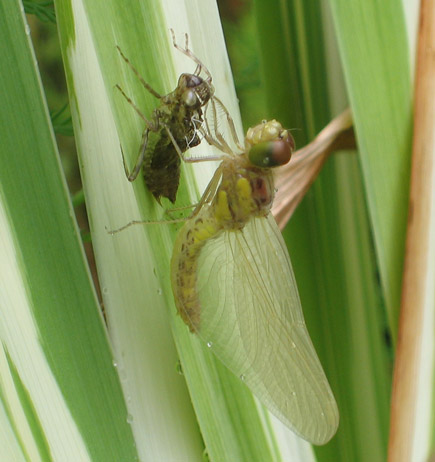Dragonfly Emerging from our Office Pond
Dragonfly – Caught in the Act
A pleasant way to spend our mid-morning and afternoon breaks is to sit outside on the stone rockery that surrounds our office pond and watch the various goings on in our little watery ecosystem that we have created. As well as all the excitement and drama of our first tadpoles, documented in our “Frog Blog” articles we are able to observe the daily goings on with the various species of water beetles, water boatmen and other invertebrates that inhabit the pond.
Damselflies are a common sight as they dart around. This time of year, we often witness the squabbles amongst them and the aerial combat as they compete for mates. We know that a number of eggs are laid in the pond and we often see larvae going about their business amongst the pond weed. The larvae are one of the many predators that inhabit the murky depths, but they have to be careful as if they stray into open water then the water boatman will grab them. However, the many damselflies we see are not the biggest members of the insect Order Odonata we observe. Occasionally, one of the dragonfly larvae will climb up a reed stem and slowly but surely escape its final larvae stage and emerge as a fully formed winged adult.
Dragonfly
We think that the dragonfly species inhabiting our little pond is the Common Darter (Sympetrum striolatum) a species that is abundant throughout most of the UK and is often found near garden ponds. We have been able to observe the larvae in the pond and have found an exuviae (the animal’s cast skin or covering from which the adult emerges), on a reed stem.
Yesterday we were able to observe an adult emerging. A Common Darter had climbed halfway up a reed stem and begun its metamorphosis. It had probably started this process around dawn, but by the time of our first break it had partially emerged and we were able to take some photographs and record the time taken for the process to be completed.
Dragonfly Emerging

Picture credit: Everything Dinosaur
This picture was taken at 11.28am, approximately 2 hours after this activity was first spotted. The dragonfly has just emerged from the exuviae and is trying to warm up and pump blood into its delicate paired wings. Team members reported that the animal was able to take to the air at around 12.30pm. It stayed around the pond for a few hours but by our mid-afternoon break it had disappeared, perhaps to find an open area so that it could hunt.
An Ancient Group of Insects
Dragonflies are a very ancient group of insects, they were certainly abundant by the Carboniferous period (354 to 290 million years ago) and some of them such as Meganeura were truly huge with wingspans of 70 cm or more. Modern dragonflies are little changed from their ancient ancestors although none of them are able to grow to the proportions of the dragonflies from the Palaeozoic. By this time in Earth’s history the arthropods such as millipedes, spiders and insects had successfully adapted to life on land and were thriving in the warm, tropical conditions.
Dragonflies (and other arthropods), were able to become giants due to the environment in which they lived. During this time in our planet’s history oxygen levels began to increase in the atmosphere, it is believed that oxygen levels peaked at around 30% at the end of the Carboniferous, a very high level when compared to the 20.9% of oxygen in our atmosphere today. Insects absorb oxygen into their muscles and other organs via tiny tubes that link their exoskeletons to the atmosphere. The greater concentrations of atmospheric oxygen permitted these animals to become more efficient and this led to the evolution of larger forms. High levels of oxygen would have also made the air denser and thus easier for a relatively heavy animal to fly in and the vertebrates were still relatively primitive during this period and were only just evolving into more capable predators so the invertebrates were able to exploit a large number of environmental niches and dominate the Carboniferous forests.
Everything Dinosaur stocks a range of arthropod models: Prehistoric Animal Models and Figures.

